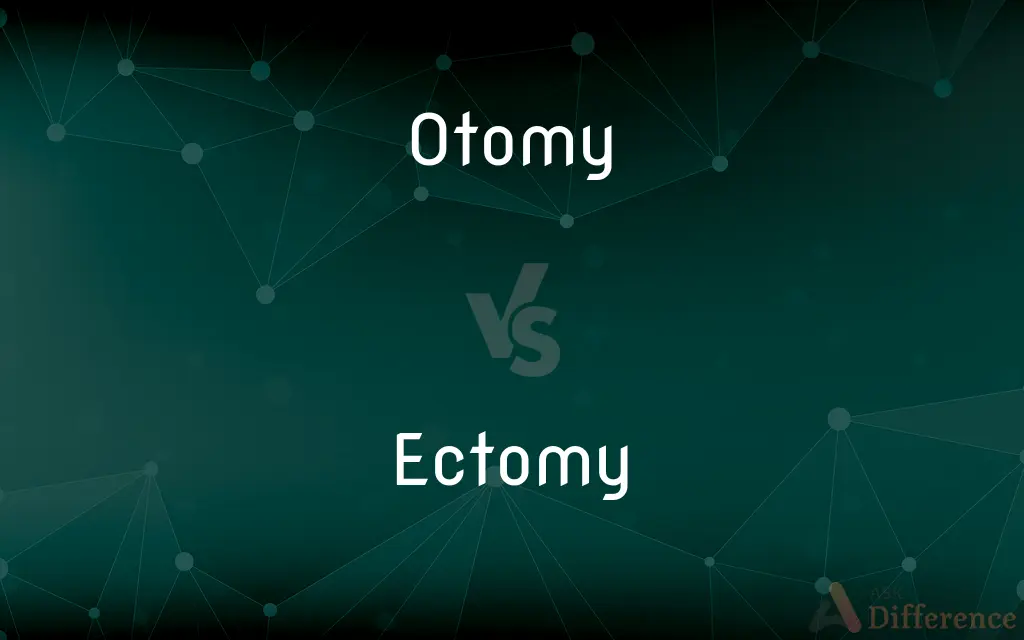Otomy vs. Ectomy — What's the Difference?
By Fiza Rafique & Maham Liaqat — Updated on April 1, 2024
Otomy involves making an incision into a body part or organ, while ectomy refers to the surgical removal of a part or organ.

Difference Between Otomy and Ectomy
Table of Contents
ADVERTISEMENT
Key Differences
Otomy procedures are surgical techniques that involve cutting into an organ or tissue to create an opening, repair, or inspect it. This type of surgery is often part of diagnostic processes or treatments that require access to an internal area without removing tissue or organs. Ectomy surgeries, on the other hand, are carried out with the intention of removing something from the body. This could be a tumor, an organ, or damaged tissue. The purpose is often to treat a condition by eliminating the problematic part.
While otomy procedures are primarily focused on providing access or altering a structure without removal, ectomy surgeries are definitive in their approach to remove the cause of a problem, such as diseased or malfunctioning organs or tissues. The distinction between the two is crucial in medical practice, as the choice of procedure depends on the diagnosis, the part of the body affected, and the overall goal of treatment.
In some medical cases, an otomy procedure may precede an ectomy. For instance, a surgeon may first perform an otomy to explore the extent of disease or damage before proceeding with an ectomy to remove the affected tissue or organ. This phased approach allows for precise removal while minimizing harm to surrounding tissues.
The terminologies reflect the surgical approach and intent: "otomy" comes from the Greek word "tomē," meaning "cutting," indicating an incision or opening, while "ectomy" is derived from the Greek word "ektemnein," meaning "to cut out," highlighting the removal aspect of such surgeries.
Comparison Chart
Definition
Surgical incision into a body part or organ.
Surgical removal of a part or organ.
ADVERTISEMENT
Purpose
To access, inspect, or repair without removal.
To treat or prevent a condition by removing the problematic part.
Examples
Tracheotomy, Laparotomy.
Appendectomy, Mastectomy.
Outcome
Creates an opening or alters a structure without removal.
Removes the cause of a problem, such as diseased organs.
Surgical Approach
Focused on providing access or altering without removal.
Definitive approach aimed at removing problematic tissues or organs.
Compare with Definitions
Otomy
Diagnostic or treatment purposes.
Arthrotomy, the opening of a joint, is performed to diagnose or treat joint issues.
Ectomy
Surgical removal.
An appendectomy involves the removal of the appendix to treat appendicitis.
Otomy
Surgical incision.
A tracheotomy involves making an incision to access the trachea for breathing assistance.
Ectomy
Aimed at treating conditions.
A mastectomy, the removal of breast tissue, is performed to treat or prevent breast cancer.
Otomy
Creates an opening.
Gastrostomy creates an opening in the stomach for feeding tubes.
Ectomy
Removes problematic parts.
Cholecystectomy, the removal of the gallbladder, is done to address gallstone issues.
Otomy
Does not involve removal.
A colotomy involves opening the colon to remove blockages without removing any part of the colon itself.
Ectomy
Definitive treatment approach.
Lobectomy, removing a lobe of the lung, is used in the treatment of lung cancer.
Otomy
Alteration of structure.
Myotomy, the cutting of muscle, is used to relieve muscular disorders without removing muscle tissue.
Ectomy
Can be preventive.
Hysterectomy, the removal of the uterus, may be performed to prevent the possibility of cancer.
Ectomy
(medicine) Any operation involving surgical excision or removal.
Common Curiosities
Why would a doctor choose an otomy over an ectomy?
A doctor might choose an otomy for diagnostic purposes, to provide treatment access, or when removal is not necessary or too risky.
Are otomy procedures less invasive than ectomy procedures?
Otomy procedures can be less invasive in that they don't involve removal, but the level of invasiveness also depends on the specific procedure and site.
Is recovery from an otomy procedure faster than from an ectomy?
Recovery can vary widely but may be faster for otomy procedures since they typically involve less alteration to the body's structures.
What is the key difference between otomy and ectomy procedures?
The key difference is that otomy involves making an incision into an organ without removal, while ectomy involves the removal of an organ or tissue.
Can otomy and ectomy procedures affect the function of the organ involved?
Yes, both can affect function, with ectomy procedures typically having a more significant impact due to the removal of an organ or tissue.
What are the risks associated with ectomy procedures?
Risks can include infection, complications from anesthesia, and the specific risks associated with the loss of the removed organ or tissue.
Are there any conditions that exclusively require an ectomy procedure?
Conditions that involve diseased or irreversibly damaged organs, such as cancerous tumors, often require ectomy procedures.
How are advancements in medical technology impacting the choice between otomy and ectomy?
Advances in medical technology are providing more options for less invasive treatments, potentially reducing the need for ectomy procedures in some cases.
Can an otomy procedure become an ectomy?
Yes, in some cases, an otomy may be the first step in exploring or diagnosing before proceeding to an ectomy for removal.
How do medical professionals decide between otomy and ectomy?
The decision is based on the diagnosis, the goal of treatment, the overall health of the patient, and the potential benefits versus risks.
Share Your Discovery

Previous Comparison
Snitch vs. Narc
Next Comparison
Tetany vs. TetanusAuthor Spotlight
Written by
Fiza RafiqueFiza Rafique is a skilled content writer at AskDifference.com, where she meticulously refines and enhances written pieces. Drawing from her vast editorial expertise, Fiza ensures clarity, accuracy, and precision in every article. Passionate about language, she continually seeks to elevate the quality of content for readers worldwide.
Co-written by
Maham Liaqat















































